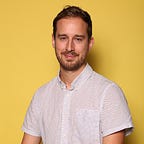How does BuzzFeed Product Design approach hiring?
Our hiring process is optimized for speed and humanity. We, the product design team handle our own hiring, not HR or recruiting. This ensures your portfolio gets the attention it deserves and allows us to move quickly when we find a great candidate for an open role. Our hiring process is designed around mutual respect and transparency because we believe this is the best way to ensure a great fit for both sides of the table.
What makes a good candidate?
We opt for generalists, designers who can take a project from inception all the way through to implementation and everything in between. UX, visual design, prototyping and great communication are some of the skills we value, more detail can be found in our roles doc. Everyone on our team is full-time and based onsite in NYC or LA, we find this to be more effective than working with freelancers or remote employees. Sometimes we meet fantastic product designers who just aren’t a good fit for how we work, or the timing doesn’t work out. We’re a small team so don’t have the luxury of hiring people into roles that don’t exist yet.
How big is the team and how is it structured?
We are 14 people and growing! 10 individual contributors, 3 managers and a VP of Design. We operate using a hybrid model meaning designers are embedded (and sit with) their squads, but come together at least twice a week as a team for portfolio critiques and other team activities. BuzzFeed Tech’s senior management structure gives an equal seat to Design, Product, Engineering and Data Science, having each discipline report directly to our publisher.
When reviewing portfolios, what do you look for?
We typically spend a couple of minutes looking over each portfolio we receive, primarily looking at three areas:
- Final output — What was shipped? How clear are the flows? How polished are the screens? Is there a prototype or animation that highlights the details of the experience?
- Design process, concisely communicated — What process did this project involve? Why tackle this problem in the first place? What artifacts (sketches, wireframes, prototypes etc) were created during the journey? What ideas were tried and discarded? How was the final solution arrived upon? Does the solution actually solve the problem it set out to achieve? Is this person an articulate written communicator? Is it easy to scan and get a quick sense of the work involved?
- Role on project — What other disciplines collaborated on this project? Did they collaborate with other designers too? If so, what was their role specifically?
Our favorite portfolios tend to feature 3–4 focused case studies. We also like to see résumé’s (or LinkedIn profiles) although the portfolio is the most important part.
Do you offer internships or hire associate designers?
Historically we’ve offered one internship in the summer. In many ways the standard we hold for interns is similar to what we hold for associate designers, reflected in IC1 in our roles doc. We’re less interested in experience than we are in raw skill. We don’t expect interns to be great at every criteria, but strong core skills in visual design, UX, process and communication typically make candidates stand out most.
What does the hiring process look like?
- Initial chat (15–30 mins)—A quick conversation with a design manager. We’ll tell you about the specific roles we have open, get to know a bit more about you and answer any questions you may have. This chat is pretty casual, and focused on identifying potential for a good fit.
- Portfolio Review (45–60 mins)—This is the part where we look through your work. We’d love to see 2–3 projects you’ve worked on in the past, from conception (how did it start) to launched product. While the finished product is important, it’s even more important to share the messiest parts of your process: what did you try that didn’t work? What variations did you come up with before narrowing down to the one you shipped? Which portions of the work generated friction or disagreement with your team or other stakeholders? Did you run experiments? If so, what did you learn?
- Teamwork + Collaboration (45–60 mins)—This chat focuses on softer skills such as collaboration, communication and the areas you’re looking to grow. Our goal is to learn how you work best and what your experience has been across the teams you’ve previously worked on. How do you like to handoff work to engineers? How did you resolve conflict on a recent project? What makes a great team? How does your ideal team collaborate together?
- Outstanding Questions—Following our initial conversations we often have areas we weren’t able to uncover in enough detail. We typically opt for a paid design exercise or a more focused portfolio review to resolve these outstanding questions before inviting someone on-site for an interview loop.
- On-site loop (5 hours)—This is the fun part! You join us on site and meet the people your role would work closest with. The first hour is a group portfolio review, where you’ll talk through a slide deck of a couple of recent projects (from inception to shipping to what you learned). It’s really important to show and talk about your process. This group session provides everyone the same context for the 1:1s that follow, these are 45 minute conversations you’ll have with the engineers, product managers and designers from the room, typically 4–6 people. Expect at least one interview to include a white boarding exercise and another to involve a lightweight html/css exercise to see how you learn and think through engineering problems.
And that’s it. Interested?
We’ve filled all our open roles for 2017 but keep an eye on this Medium publication or Cap, Kelsey, Caylee & Tom for new opportunities as they arise.
